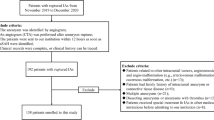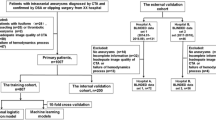Abstract
Background
Determining the rupture risk of unruptured intracranial aneurysm is crucial for treatment strategy. The purpose of this study was to predict the rupture risk of middle cerebral artery (MCA) aneurysms using a machine learning technique.
Methods
We retrospectively reviewed 403 MCA aneurysms and randomly partitioned them into the training and testing datasets with a ratio of 8:2. A generalized linear model with logit link was developed using training dataset to predict the aneurysm rupture risk based on the clinical variables and morphological features manually measured from computed tomography angiography. To facilitate the clinical application, we further constructed an easy-to-use nomogram based on the developed model.
Results
Ruptured MCA aneurysm had larger aneurysm size, aneurysm height, perpendicular height, aspect ratio, size ratio, bottleneck factor, and height-width ratio. Presence of a daughter-sac was more common in ruptured than in unruptured MCA aneurysms. Six features, including aneurysm multiplicity, lobulations, size ratio, bottleneck factor, height-width ratio, and aneurysm angle, were adopted in the model after feature selection. The model achieved a relatively good performance with areas under the receiver operating characteristic curves of 0.77 in the training dataset and 0.76 in the testing dataset. The nomogram provided a visual interpretation of our model, and the rupture risk probability of MCA aneurysms can be directly read from it.
Conclusion
Our model can be used to predict the rupture risk of MCA aneurysm.



Similar content being viewed by others
Data Availability
The datasets analyzed during the current study are available from the corresponding author on a reasonable request.
References
Rustemi O, Alaraj A, Shakur SF, Orning JL, Du X, Aletich VA, Amin-Hanjani S, Charbel FT (2015) Detection of unruptured intracranial aneurysms on noninvasive imaging. Is there still a role for digital subtraction angiography? Surg Neurol Int 6:175
van Gijn J, Kerr RS, Rinkel GJE (2007) Subarachnoid haemorrhage. Lancet 369(9558):306–318
Yu Z, Zheng J, Guo R, Li M, Li H, Ma L, You C (2020) The accuracy of aneurysm size in predicting rebleeding after subarachnoid hemorrhage: a meta-analysis. Neurol Sci 41(7):1843–1850
Thompson BG, Brown R Jr, Amin-Hanjani S, Broderick JP, Cockroft KM, Connolly E Jr, Duckwiler GR, Harris CC, Howard VJ, Johnston SC (2015) Guidelines for the management of patients with unruptured intracranial aneurysms: a guideline for healthcare professionals from the American Heart Association/American Stroke Association. Stroke 46(8):2368–2400
Etminan N, Rinkel GJ (2016) Unruptured intracranial aneurysms: development, rupture and preventive management. Nat Rev Neurol 12:699–713
Greving JP, Wermer MJ, Brown RD, Morita A, Juvela S, Yonekura M, Ishibashi T, Torner JC, Nakayama T, Rinkel GJ (2014) Development of the PHASES score for prediction of risk of rupture of intracranial aneurysms: a pooled analysis of six prospective cohort studies. Lancet Neurol 13(1):59–66
Sonobe M, Yamazaki T, Yonekura M, Kikuchi H (2010) Small unruptured intracranial aneurysm verification study. Stroke 41(9):1969–1977
Xia N, Liu Y, Zhong M, Zhuge Q, Fan L, Chen W, Yang Y, Zhao B (2016) Smoking associated with increased aneurysm size in patients with anterior communicating artery aneurysms. World Neurosurg 87:155–161
Kirino T, Hashi K, Neuro P (2012) The natural course of unruptured cerebral aneurysms in a Japanese cohort. N Engl J Med 366(26):2474
Ujiie H, Tamano Y, Sasaki K, Hori T (2001) Is the aspect ratio a reliable index for predicting the rupture of a saccular aneurysm? Neurosurgery 48(3):495–503
Wiebers DO (2003) Unruptured intracranial aneurysms: natural history, clinical outcome, and risks of surgical and endovascular treatment. Lancet 362(9378):103–110
Elsharkawy A, Lehecka M, Niemela M, Kivelev J, Billongrand R, Lehto H, Kivisaari R, Hernesniemi J (2013) Anatomic risk factors for middle cerebral artery aneurysm rupture: computed tomography angiography study of 1009 consecutive patients. Neurosurgery 73(5):825–837
Jiang P, Liu Q, Wu J, Chen X, Li M, Li Z, Yang S, Guo R, Gao B, Cao Y, Wang S (2018) A novel scoring system for rupture risk stratification of intracranial aneurysms: a hemodynamic and morphological study. Front Neurosci 12:596
Xu Z, Kim BS, Lee KS, Choi JH, Shin YS (2019) Morphological and clinical risk factors for the rupture of posterior communicating artery aneurysms: significance of fetal-type posterior cerebral artery. Neurol Sci 40(11):2377–2382
Tafti AP, Larose E, Badger JC, Kleiman R, Peissig PL (2017) Machine learning-as-a-service and its application to medical informatics. In: machine learning and data mining in pattern recognition. p 206-219
Ker J, Wang L, Rao J, Lim T (2018) Deep learning applications in medical image analysis. IEEE Access 6:9375–9389
Liu J, Chen Y, Lan L, Lin B, Chen W, Wang M, Li R, Yang Y, Zhao B, Hu Z, Duan Y (2018) Prediction of rupture risk in anterior communicating artery aneurysms with a feed-forward artificial neural network. Eur Radiol 28(8):3268–3275
Liu Q, Jiang P, Jiang Y, Ge H, Li S, Jin H, Li Y (2019) Prediction of aneurysm stability using a machine learning model based on pyradiomics-derived morphological features. Stroke 50(9):2314–2321
Zhu W, Li W, Tian Z, Zhang Y, Yang X (2020) Stability assessment of intracranial aneurysms using machine learning based on clinical and morphological features. Transl Stroke Res (7)
Forget TR Jr, Benitez R, Veznedaroglu E, Sharan A, Mitchell W, Silva M, Rosenwasser RH (2001) A review of size and location of ruptured intracranial aneurysms. Neurosurgery 49(6):1322–1326
Vlak MHM, Algra A, Brandenburg R, Rinkel GJE (2011) Prevalence of unruptured intracranial aneurysms, with emphasis on sex, age, comorbidity, country, and time period: a systematic review and meta-analysis. Lancet Neurol 10(7):626–636
Elsharkawy A, Lehecka M, Niemela M, Billongrand R, Lehto H, Kivisaari R, Hernesniemi J (2013) A new, more accurate classification of middle cerebral artery aneurysms: computed tomography angiographic study of 1,009 consecutive cases with 1,309 middle cerebral artery aneurysms. Neurosurgery 73(1):94–102
Shariat SF, Karakiewicz PI, Godoy G, Lerner SP (2009) Use of nomograms for predictions of outcome in patients with advanced bladder cancer. Ther Adv Urol 1(1):13–26
Ing E, Ing R (2018) The use of a nomogram to visually interpret a logistic regression prediction model for giant cell arteritis. Neuro-Ophthalmology 42(5):284–286
Zhang J, Can A, Mukundan S, Steigner ML, Castro VM, Dligach D, Finan S, Yu S, Gainer VS, Shadick NA (2019) Morphological variables associated with ruptured middle cerebral artery aneurysms. Neurosurgery 85(1):75–83
Meng H, Feng Y, Woodward SH, Bendok BR, Hanel RA, Guterman LR, Hopkins LN (2005) Mathematical model of the rupture mechanism of intracranial saccular aneurysms through daughter aneurysm formation and growth. Neurol Res 27(5):459–465
Dhar S, Tremmel M, Mocco J, Kim M, Yamamoto J, Siddiqui AH, Hopkins LN, Meng H (2008) Morphology parameters for intracranial aneurysm rupture risk assessment. Neurosurgery 63(2):185–197
Xiang J, Tutino VM, Snyder KV, Meng H (2014) CFD: computational fluid dynamics or confounding factor dissemination? The role of hemodynamics in intracranial aneurysm rupture risk assessment. AJNR Am J Neuroradiol 35(10):1849–1857
Murayama Y, Takao H, Ishibashi T, Saguchi T, Ebara M, Yuki I, Arakawa H, Irie K, Urashima M, Molyneux AJ (2016) Risk analysis of unruptured intracranial aneurysms: prospective 10-year cohort study. Stroke 47(2):365–371
Neyazi B, Sandalcioglu IE, Maslehaty H (2019) Evaluation of the risk of rupture of intracranial aneurysms in patients with aneurysmal subarachnoid hemorrhage according to the PHASES score. Neurosurg Rev 42(2):489–492
Pagiola I, Mihalea C, Caroff J, Ikka L, Chalumeau V, Iacobucci M, Ozanne A, Gallas S, Marques M, Nalli D, Carrete H, Caldas JG, Frudit ME, Moret J, Spelle L (2019) The PHASES score: to treat or not to treat? Retrospective evaluation of the risk of rupture of intracranial aneurysms in patients with aneurysmal subarachnoid hemorrhage. J Neuroradiol 47:349–352
Silva MA, Patel J, Kavouridis VK, Gallerani T, Beers A, Chang K, Hoebel K, Brown JA, See AP, Gormley WB (2019) Machine Learning models can detect aneurysm rupture and identify clinical features associated with rupture. World Neurosurg 131:e46–e51
Tanioka S, Ishida F, Yamamoto A, Shimizu S, Sakaida H, Toyoda M, Kashiwagi N, Suzuki H (2020) Machine learning classification of cerebral aneurysm rupture status with morphologic variables and hemodynamic parameters. Radiology: Artific Intell 2(1):e190077
Lall RR, Eddleman CS, Bendok BR, Batjer HH (2009) Unruptured intracranial aneurysms and the assessment of rupture risk based on anatomical and morphological factors: sifting through the sands of data. Neurosurg Focus 26(5):E2
Kleinloog R, de Mul N, Verweij BH, Post JA, Rinkel GJE, Ruigrok YM (2017) Risk Factors for intracranial aneurysm rupture: a systematic review. Neurosurgery 82(4):431–440
Signorelli F, Sela S, Gesualdo L, Chevrel S, Tollet F, Pailler-Mattei C, Tacconi L, Turjman F, Vacca A, Schul DB (2018) Hemodynamic stress, inflammation, and intracranial aneurysm development and rupture: a systematic review. World Neurosurg 115:234–244
Funding
This study was supported by the Basic Research Project of Wenzhou (Y2020166), Wenzhou Major Program of Science and Technology Innovation (ZY2020012), Health Foundation for Creative Talents in Zhejiang Province, China (No.2016), and Natural Science Foundation of Zhejiang Province, China (Grant No. LQ15H180002).
Author information
Authors and Affiliations
Contributions
Jinjin Liu, Xiufen Jia, and Yunjun Yang contributed to the study conception and design. Material preparation, data collection, and analysis were performed by Jinjin Liu, Xiufen Jia, Jiafeng Zhou, Boli Lin, Dongqing Zhu, Qiong Li, and Zhonggang Chen. The first draft of the manuscript was written by Jinjin Liu, and all authors commented on previous versions of the manuscript. All authors read and approved the final manuscript.
Corresponding authors
Ethics declarations
Conflict of interest
The authors declare no competing interests.
Ethical approval
This study was approved by the ethical committee of the First Affiliated Hospital of Wenzhou Medical University.
Informed consent
Informed consent was obtained from all patients involved in the study.
Additional information
Publisher’s note
Springer Nature remains neutral with regard to jurisdictional claims in published maps and institutional affiliations.
Rights and permissions
About this article
Cite this article
Liu, J., Chen, Y., Zhu, D. et al. A nomogram to predict rupture risk of middle cerebral artery aneurysm. Neurol Sci 42, 5289–5296 (2021). https://doi.org/10.1007/s10072-021-05255-6
Received:
Accepted:
Published:
Issue Date:
DOI: https://doi.org/10.1007/s10072-021-05255-6




